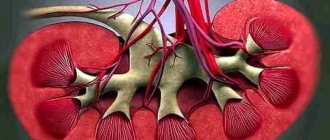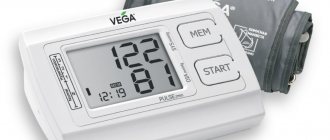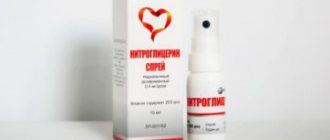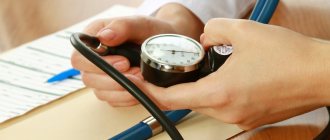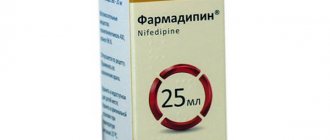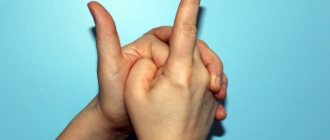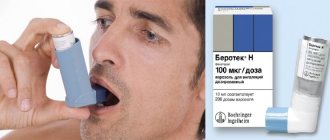Ways to reduce pressure
To reduce blood pressure, specialists prescribe special medications that block the formation of angiotensin and drugs called “angiotensin-converting enzyme inhibitors.”
In order for treatment to be as effective as possible, it is necessary first to determine the cause of the increase in pressure.
Basically, therapy for high cardiac pressure is carried out in a hospital, and only after the general condition improves, the patient can be discharged home, but with the condition of continuing treatment.
In addition, patients who often develop crises are subject to hospitalization, which may be a consequence of the progression of the underlying disease or the development of complications.
If drug therapy does not produce the desired effect and there is a risk of developing complications, surgical treatment methods are used, such as replacing a valve located on the aorta, correcting vascular abnormalities, etc.
If it is impossible to identify the cause of hypertension, a diagnosis of essential arterial hypertension is made. In this case, treatment is aimed at eliminating the symptoms of the disease.
You can reduce your blood pressure using the following recommendations:
- Diet.
It is diet that needs to be given the most attention in case of pathologies of the cardiovascular system. It is necessary to adhere to a diet enriched with vitamins and minerals that the heart muscle needs. Experts recommend adhering to a dairy-vegetable diet, which will include a sufficient amount of berries, fruits and vegetables to ensure normal heart function. You also need cereals such as oatmeal, rice, buckwheat porridge and wholemeal bread, or grain bread. Dairy products and meat should be low-fat, eat plenty of fish. It is necessary to limit, and if possible completely eliminate, baked goods, fatty, sweet, smoked and salty foods. - Physical activity is recommended for any diseases of the cardiovascular system.
However, if you do gymnastics or physical therapy, you must definitely agree with your doctor, and it is advisable to do it under his close supervision. But you can take a walk before bed on your own. And try to walk more often, for example, to the store or to work. - Green tea will help reduce blood pressure very well
. If you take this drink regularly, you can not only get rid of problems associated with high blood pressure, but also prevent the development of atherosclerosis of blood vessels. - Traditional healers recommend taking one clove of garlic every day before breakfast
, and washing it down with one-third glass of water with one teaspoon of apple cider vinegar.
It must be remembered that blood pressure does not increase randomly, but this is a kind of protective reaction of the body. If you constantly knock it down, you may increase the risk of developing other diseases due to the accumulation of various problems. But if the pressure is not reduced, life-threatening complications may develop. This may be a thickening of the walls of blood vessels, an increase in the volume of the cavity of the heart ventricles, or the appearance of atherosclerotic plaques in the blood vessels.
The criterion for normal blood pressure levels for your body is the best overall health and the highest degree of performance.
It is also necessary to remember that high upper pressure is provided by the aorta. It is not formed by the heart, so its increase does not pose a danger to the heart muscle.
Chronic arterial hypertension is bad, but it’s just as bad if it’s constantly brought down
In this case, specialists pay attention to kidney function; when it is normalized, blood pressure in most cases stabilizes on its own. There is also a method of treating hypertension, which is aimed at regulating the production of hormones in the body, which contribute to increased pressure and spasm in the blood vessels, as well as a change in the direction of blood flow
woman-v.ru
Emergency help
If the readings have increased and the symptoms are unbearable, you can quickly reduce the lower pressure by placing the patient in a lying position, face down. The person providing assistance applies ice to the patient's neck. As soon as the ice begins to melt, it is removed. The area is not intensively massaged, lubricating your hands with peach oil. After 10 minutes the symptoms will disappear.
Before lowering your low blood pressure at home, pay attention to the numbers: if they are critical, you should first call an ambulance.
Methods for reducing DD
It is important to determine the reason why lower blood pressure increases and know how to properly reduce lower blood pressure. If the cause is clogged arteries, then you need to use recipes to cleanse them.
If there is a problem with the kidneys, diuretics will come to the rescue. You can lower blood pressure with garlic. It is recommended to use an infusion with milk. Five cloves of garlic need to be chopped and poured into a glass of milk. Leave the whole mixture for two hours. Divide the drink into two doses.
Traditional recipes have a high impact. You can quickly lower your blood pressure with honey and lemon. To prepare the medicine you will need 200 ml of mineral water, 1 tablespoon of honey and juice from half a lemon. All ingredients must be combined and mixed well. Drink the resulting mixture in one go. If elevated lower blood pressure has already become chronic, the drug should be used daily. In order to reduce DD at home, use peony tincture. It helps cope with muscle spasms. Take 20 drops three times a day after meals.
The disease is treated with valerian root. The dried roots are ground into powder and consumed three grams twice a day. An infusion is also prepared from the roots: 10 grams of roots are poured with a glass of boiling water and kept at a boil for half an hour. Allow the product to cool and consume. Drink three tablespoons five times a day after meals.
A rosehip drink helps to quickly lower blood pressure; you can drink it without any restrictions. All of the listed recipes also cannot be used in case of low diastolic pressure.
Symptoms of diastolic hypertension
Before you start lowering your blood pressure, you should check your symptoms. The ideal way to find out the indicators at a point in time is to measure the values with a tonometer. Typically, the question of how to lower the lower pressure of 100 arises extremely rarely, since such a value may not cause signs of illness and is determined only by the instrumental method.
Mainly, the fact that the diastolic numbers are outside the normal range is indicated by:
- headache (with pulsation in the temples, bursting, aching, in the frontal area or crown);
- tachycardia with pain in the heart muscle;
- increased heart rate, panic attacks, hypoxia;
- tremor in all parts of the body;
- loss of strength, weakness, dizziness.
If such a clinical picture makes itself felt, this is, of course, a reason to consult a doctor, but you can help the body with minor deviations from the norm if you know how to reduce low blood pressure at home.
Treatment
It depends on the reasons for the increase in diastolic blood pressure. Once the disease causing the increase in lower blood pressure is determined, the attending physician will determine which treatment will be optimal. Most often, blood pressure is reduced with the help of drugs. If medications do not help, and there is a risk of developing severe complications, surgery is indicated (correction of vascular abnormalities, replacement of the aortic valve, etc.).
In some cases, the cause of the increase in lower blood pressure cannot be determined. Then symptomatic treatment is prescribed, the purpose of which is to reduce blood pressure.
Taking medications is not enough to lower blood pressure
It is important to follow a daily routine, adhere to a diet, and eliminate smoking and alcohol. . Mode
Mode
With high blood pressure, proper rest is necessary: it is advisable to sleep not only at night, but also during the daytime. A quiet hour can be replaced by a walk in a quiet place, during which it is advisable to relax and disconnect from everyday worries. If possible, it would be a good idea to take a short nap during your lunch break - 10-15 minutes.
A person who has established relaxation becomes calmer, many ailments go away, including high blood pressure
Physical education classes can be useful for diseases of the heart and blood vessels, but they should only be done in consultation with the attending physician.
Nutrition
The diet should be designed in such a way that foods include vitamins and minerals important for heart function. Cardiologists usually recommend dairy-vegetable foods. And, of course, it is important to reduce weight if you have extra pounds and maintain it at normal levels.
The basic nutritional rules are as follows:
- You need to include more berries, vegetables, fruits, and herbs in your diet.
- Low-fat dairy products, lean fish and meat must be on the table.
- Cereals are very healthy: grain bread or wholemeal bread, porridge, especially buckwheat, oatmeal, and rice.
- You can leave the salt, but you need to reduce your consumption.
- It is better to avoid smoked, salty, spicy, rich, sweet and fatty foods or eat them in minimal quantities.
- Reduce tea and coffee consumption, eliminate alcohol and soda.
Causes and dangers of high lower pressure
Normal lower pressure varies from 80 to 90 units. Most often it increases in the presence of other diseases - these are:
- diseases of the kidneys and adrenal glands;
- disorders of the pituitary gland;
- diseases of endocrine organs;
- decreased tone of the heart muscle;
- spinal hernia;
- neurosis, stressful conditions;
- hormonal imbalance;
- malfunction of the thyroid gland;
- presence of heart disease;
- formation of tumors of various etiologies;
- genetic predisposition.
Lower blood pressure can change throughout the day even in healthy people, for example, with increased emotional or physical stress. But in this case it tends to decrease on its own and there is no danger in this.
This disease has the following degrees:
- soft (from 90 to 99);
- moderate (from 100 to 109);
- heavy (from 110 to 120).
Higher blood pressure generally means that the heart is unable to work properly and the blood is moving with increased effort. If only lower blood pressure is elevated, then this indicates problems in the functioning of blood vessels and the circulatory system as a whole. Blood cannot fully perform its tasks due to poor functioning of blood vessels. As a result, the entire human body wears out and a stroke or heart attack can occur. In addition, atherosclerosis can form. With this disease, lipid-protein metabolism and the elasticity of blood vessels are disrupted, which leads to the deposition of cholesterol on their walls and the formation of plaques. Stagnation of blood can contribute to heart failure.
Another serious danger is changes in the brain. This is expressed in memory and intelligence impairments. Kidney failure may occur. As a result, the kidneys cease to perform the function of removing toxins, which leads to slow poisoning of the human body.
What is heart pressure
Blood pressure is an indicator of two numbers - SD and DD. The norm is a ratio of 120 to 80 mmHg. Art. The first number is recorded at the peak moment of the load on the heart, when the heart muscle and large muscles release blood into the body. The second indicator is a state of complete rest. The difference between these data should not exceed 40-60 mmHg. Art. or be reduced below these figures. Systole is considered the most dangerous in moments of crisis, when the load on the blood flow is maximum.
A stable difference between DM and DD allows you to fully live, work and play sports. A constant deviation in any direction characterizes the presence of the disease. An increase in DD after physical activity or at a time of stress is a natural phenomenon. However, if such a condition has a systematic manifestation, then you need to be examined for undetected heart diseases.
Why is high DD dangerous?
The pressure on the walls of blood vessels can change with age, against the background of hormonal changes in the body (pregnancy, puberty), due to illness. If it remains within the limits of acceptable changes or returns to normal on its own, then there is no serious danger (instant critical changes are not meant). If you have prolonged elevated heart pressure for no apparent reason, you should consult a doctor: the cause and degree of hypertension will be identified. After the examination, the doctor will prescribe what to drink if you have high blood pressure.
| 11111111111111111111111111 | “When I found a way to clean blood vessels with the help of plants, it was as if I became younger - my brain started working like it did at 35, and my blood pressure quickly returned to normal.” Read more… |
Why is high blood pressure dangerous? Most patients have heard the name “hypertension” so often that they no longer take the disease seriously, but heart attacks, strokes and other critical events occur because of this attitude. Only 5 mm Hg. Art. above normal increases the risk of myocardial infarction by 20%. Even minimal changes in blood pressure must be treated very carefully. The effect of the disease is cumulative, and it is easier to cure it in the initial stages.
Systolic pressure in humans: what does this indicator mean, normal
By measuring pressure with a tonometer , the researcher receives two values - systolic (or upper) and diastolic (lower).
The first value means the maximum force with which blood circulates through the arteries. It is determined at the moment of contraction of the heart muscle.
The value of systolic pressure depends on the condition of the aorta and coronary vessels, the volume of the left ventricle of the heart, pulse rate, and blood ejection rate. Values from 110 to 140 mm Hg are taken as normal.
True, the standard depends on gender, weight and age. So, for 20-year-old men, the normal systolic pressure is 123 mm Hg. For representatives of the stronger sex 30 years old this figure is 126 mm Hg, 40 years old – 129, 50 years old – 135 mm Hg. For older men 60-70 years old, the standard is 142, and for people over 70 years old – 145 mmHg.
For women aged 20 years, the normal systolic value is 116, 30 years – 120, 40 years – 127, 50 years – 137, 60-70 years – 144, over 70 years – 159 mmHg.
For children, the standards are slightly lower. So, for babies under one year of age, systolic pressure should be 76 mm Hg, and over one year old – 90 mm Hg.
The maximum permissible value for small one-year-old children is 105 mmHg. Depending on the individual characteristics of the body, the pressure norm may be different. Therefore, when measuring the systolic value, you should focus on the patient’s well-being.
Causes of increased lower pressure
People who have already been diagnosed with vascular problems are at risk of developing pathology. Also, heart function should be checked in patients undergoing therapy to eliminate any endocrine diseases. During treatment, they use drugs that negatively affect cardiac function, which can cause diastole pathology. Other factors for the development of high lower pressure include the following:
The reasons for the increase in lower pressure may be fatty foods
- Abuse of foods containing high amounts of animal fat. It settles on the walls of blood vessels, which leads to their narrowing.
- Passion for salty foods, as salt reduces the elasticity of the arteries and makes them more vulnerable.
- Frequent drinking and smoking. Almost 90% of patients undergoing treatment for high diastolic pressure suffer from nicotine addiction and often drink alcohol.
- Overweight and obesity. Extra pounds force the heart to work harder, which changes the structure of arteries and small vessels. Gradually, such changes lead to the inability to pump the required volume of blood.
- Negative emotional background for a long time or short-term psycho-emotional shock. Stress and depression also depress the heart, leading to weakening of its function.
- Inflammatory processes in the body. In this case, inflammation localized in the kidneys is especially dangerous. If diastolic pressure constantly increases, this process can lead to organ failure and the need for an urgent transplant. When diagnosing kidney disease, it is worth constantly checking your blood pressure.
Drug therapy
There are medical standards that doctors adhere to when drawing up a treatment regimen. It is selected individually, since each person has his own body characteristics. To choose them correctly, you will have to undergo a full examination and identify the reason for the increase in tonometer readings. Based on the results obtained, the doctor will be able to tell you how to lower your lower blood pressure without harming the body. If you neglect this recommendation, then there is a risk of developing other pathologies due to incorrectly selected medications.
The following groups of medications are the main ones in most treatment regimens:
- Angotensin converting enzyme (ACE) inhibitors prevent the production of angiotensin II, which is involved in vasoconstriction. Zofenopril and Enalapril are mainly prescribed. In emergency cases, Ramipril is used.
- Calcium antagonists block microelement channels, having a vasodilatory effect and reducing the intensity of heart contractions. The most commonly used are Amlodipine and Diltiazem. In case of rhythm disturbance and high lower pressure, Verapamil is used.
- Beta blockers block beta adrenergic receptors, reducing the effect of adrenaline on the heart muscle. The most popular are Nebivator, Atenol, and Betak.
- Diuretics (diuretics) help remove excess moisture from the body. In most cases, Indapamide and Furasemide are used. With long-term use, it is advisable to additionally drink potassium-containing drugs (Asparkam) or potassium-sparing drugs (Amiloride, Eplerenone).
Many people are very skeptical about dietary supplements (BAA), but when used correctly, they really have a positive effect on the body. Properly selected tablets from this group will strengthen the walls of blood vessels, increase their elasticity and reduce the concentration of cholesterol in the blood.
The following drugs containing B vitamins, ascorbic acid, rutin, magnesium, calcium and other microelements are most relevant for reducing diastolic pressure:
- "Vitrum Cardio";
- "Ascorutin";
- "Novofit";
- "Asparkam."
How to lower lower blood pressure without lowering upper blood pressure
When it comes to how to reduce high lower pressure without lowering upper pressure, you should take into account the reasons that provoked this pathology. If a patient is overweight, smokes and drinks alcohol, eats unhealthy food, first of all he should lose weight, normalize his diet and improve his diet. Comprehensive treatment includes complex therapy, as well as elimination of symptoms of diseases that cause increased blood pressure.
Doctors advise increasing physical activity, ensuring proper rest, increasing sleep duration, and trying to eliminate potential sources of stress. To ensure that your blood pressure is always normal, you need to exclude fried, fatty and smoked foods, strong coffee and tea from your diet, and eat more vegetables and fruits, nuts, fish and dairy products. Taking special medications also helps eliminate the symptoms of high diastolic pressure, the systolic symptom of which is often headaches.
It's better to give up coffee completely
First aid measures
If low diastolic blood pressure reminds you from time to time, you need to visit a cardiologist or therapist to eliminate the exact cause of the pathology and prescribe the correct treatment. There are special first aid techniques that can normalize the condition for a short period and reduce diastolic readings. For this you will need:
- Lie horizontally on your stomach and slightly lower your head down, maintaining this position for several minutes.
- Apply ice wrapped in a cloth to the neck area on either side of the spine.
- Remove the compress after 30 minutes, then do a massage that restores blood circulation.
- Acupressure helps to normalize blood pressure values; for this it is necessary to massage the active points located under the earlobes.
Taking medications
Special medications help eliminate discomfort and most unpleasant symptoms, as well as lower high blood pressure to the required level. To eliminate excessive swelling of blood vessels, it is necessary to take diuretics, for example, Furosemide or Hypothiazide. To prevent the flow of adrenaline into the heart muscle area, doctors prescribe the beta blocker Atenolol or Anaprilin. Calcium channel blockers help reduce excess salt levels in the body; in addition, cardiologists recommend taking RAF inhibitors for blood vessels.
Traditional methods
In addition to the question of what diastolic pressure means, you need to know what to do if traditional methods are not suitable. Medicinal plants help cope with unpleasant symptoms and bring blood pressure levels back to normal. There are several popular recipes that can be used at any age:
- Tincture with cedar cones. To prepare the tincture, you need to take 4 cones and pour 500 ml of alcohol into them, then add 15 ml of valerian tincture and 75 g of sugar. The medicine is infused for 14 days and taken 15 ml daily before bed.
- A decoction of rowan fruits. To prepare it, grind 160 g of berries, pour 500 ml of boiling water over them and keep on low heat for 5 minutes. Add 50 ml of honey to the strained broth and leave for at least 5 days. You need to take the medicine 2 times a day, 120 ml.
First aid for hypertensive crisis
Hypertensive crisis is a dangerous condition that can lead to serious consequences, such as heart attack and acute cerebral ischemia. During a hypertensive crisis, there is a sharp jump in blood pressure readings above 140 to 90.
The condition is dangerous because a person cannot always adequately assess the complexity of the situation. Some people experience extremely high blood pressure without any symptoms. Some, when faced with manifestations of a hypertensive crisis for the first time, perceive them as fatigue, faintness and do not take the necessary measures. It is especially dangerous if a hypertensive crisis finds a person alone, far from hospitals.
Causes of hypertensive crisis:
- Severe emotional stress, nervous strain.
- Climate change, weather change (especially high outside temperature).
- Abuse of alcohol, coffee.
- Smoking.
- Skipping or refusing to take an antihypertensive drug prescribed by a doctor for lifelong use.
- Chronic diseases (diabetes mellitus, polyarteritis nodosa, nephroptosis, thyroid disease, nephropathy in pregnancy, arterial hypertension, systemic lupus erythematosus, arteriosclerotic lesions of the aorta, vascular diseases).
- Excess salt in the diet.
- Hormonal disorders, especially menopause in women.
- Overloads of the physical plane.
What pills to take during pregnancy if your blood pressure is higher than normal?
Systolic blood pressure often increases in pregnant women.
This condition poses a threat to the health and life of the expectant mother and her baby.
In pregnant women, hypertension, according to statistics, is observed in 30% of cases. If hypertension is moderate (tonometer shows 140-159 mm Hg), doctors do not recommend using synthetic antihypertensive tablets.
Because it may increase the risk of premature birth, perinatal mortality, and preeclampsia. Doctors usually advise taking vitamins B6 in combination with magnesium.
If a hypertensive crisis occurs, the pregnant woman is hospitalized and treated in an inpatient setting. The following tablets are used: Nifedipine, Labetalol, Metoprolol. If indicated, Furosemide, Clonidine, Hypothiazide, Prazosin, Verapamil are also used.
What does increased DD mean?
The first thing that elevated lower blood pressure indicates is abnormal vascular function at the time of cardiac pause and problems with the renal artery. Its job is to regulate blood pressure. In addition to this reason, increased DD can be characterized, for example, by pathology of the spinal canals. With constantly elevated diastole, completely different diseases are possible:
- heart disease – arrhythmia, defects;
- renal dysfunction;
- problems with the endocrine glands.
Increased lower blood pressure with normal upper blood pressure
It is immediately worth noting that this means increased lower pressure with normal upper pressure, which is present constantly or most of the time. A one-time short-term increase is often a reaction to an external or internal irritant. Stably elevated renal blood pressure (as lower blood pressure is sometimes called) is called diastolic hypertension. It directly indicates the presence of pathology in the body.
Signs of high diastole:
- regular dizziness, ringing or noise in the ears, spots and darkening before the eyes;
- localization of headache in the back of the head;
- pulse (HR) from 100 beats per minute or more;
- difficulty breathing, chest pain;
- sharp cold sticky sweat;
- heart contractions feel like force;
- poor general health;
- weak tone;
- Possible vomiting and nausea;
- nose bleed.
Urgent help at home and self-massage
If elevated diastolic pressure is detected, the first thing to do is call a doctor. And before his arrival, you can help your body on your own. The first option is to lie on your stomach without a pillow, applying a cold compress to the cervical spine. After 10-15 minutes, the compress must be removed and the neck area carefully massaged without excessive pressure.
You can also do a little acupressure. Points that help reduce diastolic pressure are located on the earlobes, so it is useful to thoroughly massage and rub the earlobes. During the massage, you can make significant efforts until you experience mild pain. There is no time limit for this procedure, but 5-7 minutes are enough for the lower pressure reading to begin to decrease.
In general, it is necessary to approach the treatment of high lower pressure in a comprehensive manner, combining drug therapy with folk remedies. And the foundation for a speedy healing will be a healthy lifestyle and conscious proper nutrition. Then, normal blood pressure, good health and a long, fulfilling life are guaranteed! Lower abdomen hurts during menstruation, you will find the answer in the link.
Ways to moderately lower lower pressure
not only with the help of drugs, but also by other methods. Their essence comes down to the gradual normalization of the work of the heart muscle, since an excessive desire to dilate blood vessels often leads to damage to their walls. The following tips will help you understand how to reduce lower blood pressure without harming the body:
- Change your diet. Vegetables, fruits and fermented milk products should be added to the daily menu to replace junk food. It is advisable to cook by steaming, avoiding fried and smoked foods and canned food.
- The amount of sugar and sugar-containing foods consumed should be reduced. It is recommended to use honey.
- Use table salt to a minimum. No more than 5 g is allowed daily.
- Do not abuse bad habits. Alcoholic drinks and cigarettes disrupt the functioning of internal organs and stimulate the production of adrenaline, which causes blood vessels to constrict.
- Make a work and rest schedule. You need to get at least 6-8 hours of sleep. During work, be sure to take breaks to warm up.
- Do physical therapy. If you have hypertension, you should not overexert yourself, but light physical activity has a beneficial effect on the functioning of the heart muscle. Initially, walking in the fresh air and exercise will suffice. Cardio exercises, running, swimming, cycling and exercise equipment are gradually added.
- Stress stimulates the production of adrenaline. High blood pressure is often the result of nervousness. The patient needs to avoid conflicts, and resolve serious issues after the condition improves.
You can combine advice with folk recipes. A herbalist will help you figure out how to lower your lower blood pressure with their help. He will assess the patient's condition and tell him what to do to stabilize him. The most popular recipes for lowering diastolic pressure are:
- To relieve spasms from blood vessels and strengthen their walls, drink beet juice. It is recommended not only to reduce upper pressure, but also lower pressure. Drink juice 30 ml. before meals for a month.
- Tea made from valerian, hawthorn and motherwort allows the heart to relax and reduces nervous excitability. It is enough to drink 1 cup daily, and your blood pressure will not increase as much as before taking the medicine.
- A mixture of raisins, honey, walnut kernels and dried apricots, poured with lemon juice on top, allows you to reduce high lower pressure. All components are taken in equal shares. Drink 1 tbsp of medicine in the morning on an empty stomach. l.
- Motherwort is used as a means of strengthening the myocardium. For cooking, take 2 tbsp. l. main ingredient and pour 500 ml of boiling water over them. After cooling, drink 50 ml of motherwort infusion at night.
- High lower blood pressure associated with impaired kidney function can be reduced with diuretic herbs. St. John's wort, sage and oregano are used. They need to be taken in equal parts (1 tbsp each) and add 3 tbsp on top. l. motherwort. All components are mixed in one container and 500 ml of boiling water is poured. After cooling, drink 100 ml in the morning for 30 days.
If diastolic pressure has increased sharply, then you can use the following algorithm of actions to gradually reduce it:
- If possible, lie on your stomach. The head should be facing the pillow.
- Place cold objects on the sides of the cervical spine and remove them after half an hour.
- Take any cream or oil and massage the cooled area of your neck. Movements should be light.
- All actions will take no more than 40 minutes. If diastolic pressure continues to rise, call an ambulance.
Taper techniques are effective in treating mild cases of hypertension. In advanced stages, a combination of folk recipes and lifestyle correction with drug therapy is required. Drugs are prescribed by a doctor depending on the patient’s condition and the presence of other pathological processes.
Taking a course of traditional medicine must be agreed upon with a specialist. Many components used in recipes are contained in various preparations. Their combination can cause an overdose and an attack of arterial hypertension. The doctor will have to take this nuance into account and change the dosage.
How to lower blood pressure: treatment methods
Patients suffering from endlessly recurring attacks of hypertension are well aware of how to reduce low blood pressure. When a person first encounters symptoms that disrupt their usual way of life, it should be understood that taking a pill will not solve the problem overnight. The approach to treatment must be comprehensive. It is quite natural that when diagnosing a pathology, doctors prescribe medications, but at the first symptoms, before lowering the lower blood pressure with pills, you can alleviate the condition with folk methods and home recipes.
An integrated approach includes:
- change in diet (preference is given to healthy, balanced);
- weight control (preventing obesity);
- inclusion of moderate physical activity in passive life;
- more physical activity (walks in the park, avoiding the elevator);
- maintaining a sleep schedule (at least 8 hours, no more than 10);
- alternative therapies;
- treatment with medications.
In some cases, it is quite enough to reconsider your usual lifestyle so that the pressure returns to normal and no longer bothers you. In any case, it is worth undergoing a full examination and receiving qualified advice from a specialist.
